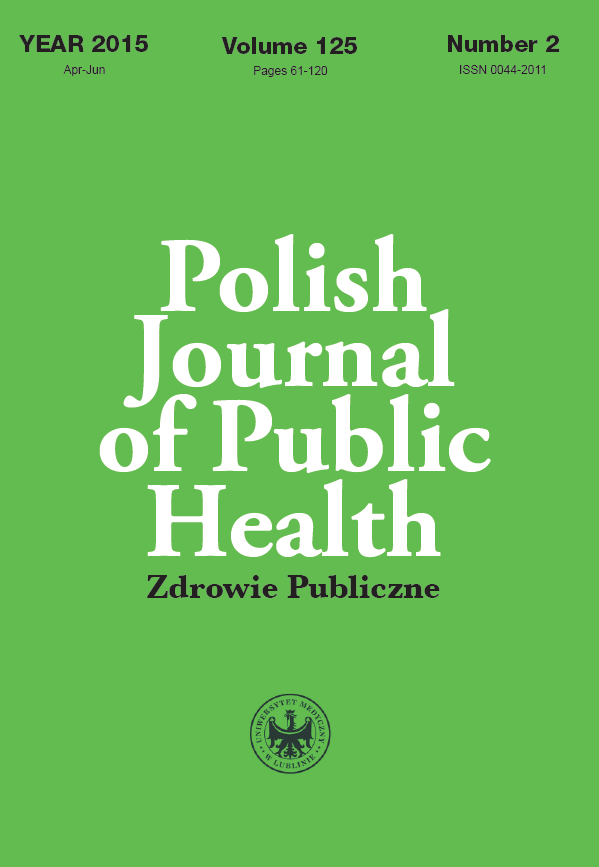Determining fetal sex in pregnancy with reference to pregnant women behavior in late pregnancy
DOI:
https://doi.org/10.1515/pjph-2015-0030Keywords:
fetal sex, pregnancy, third trimester, ultrasoundAbstract
Introduction. Pregnant women often create their own image of a child. The ultrasound is able to model and modify this picture. The image of the unborn child develops along with the process of creating the space for the baby on the psychological and emotional level and is continued after the delivery.
Aim. The authors of the study made an attempt to evaluate the influence of fetal sex determination during ultrasound in pregnancy on emotional and ‘practical’ experiencing late pregnancy – after the 28th week of its duration.
Material and methods. The study included 200 pregnant women. Qualification criteria for the research was the declared awareness of fetal sex confirmed by ultrasound. Among others, factors influencing decision to determine fetal sex, emotional bond with the unborn child after identifying the sex, as well as preparation for birth regarding prognosticated sex were
assessed.
Results. Nearly all pregnant women wanted to find out the fetal sex, usually claiming that they did so out of curiosity. After they did it, about 2/3 of them stated that the emotional bond with the baby increased and the vast majority of women started preparing layettes for their future babies.
Conclusions. Determination of fetal sex during ultrasound improves the relationship between the mother and her future baby. It also enables the woman to prepare for childbirth considering its sex by the purchase of clothes, pram and preparation of layette or baby’s room.
References
1. Popławska E. Więź emocjonalna z dzieckiem w okresie prenatalnym. Kwartalnik Naukowy Fides et Ratio. 2011;2(6):28-39.
2. Ammanti M. Maternal representations during pregnancy and early mother-infant interaction. Inf Ment Healt J. 1991;12:246-55.
3. Benoit D, Parker KC, Zeanah CH. Mothers’ representations of their in¬fants assessed prenatally: stability and association with infants’ attach¬ment classifications. J Child Psychol Psychiatry. 1997;38(3):307-13.
4. Siddiqui A, Hagglof B, Eisemann M. An exploration of prena¬tal attachment in Swedish expectant womem. J Reprod Infant Psy¬chol.1999;17(4):369-80.
5. Shettles L, Rorvik DM. Zaplanuj płeć swojego dziecka. Warszawa: Wyd. Filar; 2001.
6. Kooper AJ, Pieters JJ, Eggink AJ, et al. Why do parents prefer to know the fetal sex as part of invasive prenatal testing? ISRN Obstet Gynecol. 2012;2012:524-37.
7. Chen LC, Chen CY, Horng HC, et al. Sex ratio at a tertiary medical center in northern Taiwan--an analysis of amniocentesis; Taiwan J Obstet Gynecol. 2014;53(1):118-9.
8. Lau TK, Chan MK, Salome Lo PS, et al. Non-invasive prenatal screen¬ing of fetal sex chromosomal abnormalities: perspective of pregnant women. J Matern Fetal Neonatal Med. 2012;25(12):2616-9.
9. Hill M1, Taffinder S, Chitty LS, Morris S. Incremental cost of non-invasive prenatal diagnosis versus invasive prenatal diagnosis of fetal sex in England. Prenat Diagn. 2011;31(3):267-73.
10. Hickey J, Goldberg F. Diagnostyka USG w położnictwie i ginekologii. Gdańsk: Wyd. Med. Makmed;1997.p.9-23.
11. Reddy UM, Abuhamad AZ, Levine D, Saade GR. Fetal imaging: Executive summary of a Joint Eunice Kennedy Shriver National Insti¬tute of Child Health and Human Development, Society for Maternal-Fetal Medicine, American Institute of Ultrasound in Medicine, Ameri¬can College of Obstetricians and Gynecologists, American College of Radiology, Society for Pediatric Radiology, and Society of Radiolo¬gists in Ultrasound Fetal Imaging Workshop. Am J Obstet Gynecol. 2014;210(5):387-97.
12. Shipp TD, Shipp DZ, Bromley B, et al. What factors are associat¬ed with parents’ desire to know the sex of their unborn child? Birth. 2004;31(4):272-9.
13. Sioda T. Psychological effects of cardiotocographic and ultrasonograph¬ic examinations in pregnancy and labour on the mother. Part I. The sig¬nificance of cardiotocographic and ultrasonographic examinations for the development of maternal bonding. Ginekol Pol. 1984;55(9):653-60.
14. Fletcher JC, Evans MI. Maternal bonding in early fetal ultrasound examinations. N Engl J Med. 1983;308(7):392-3.
15. Zlotogorski Z, Tadmor O, Rabinovitz R, Diamant Y. Parental atti¬tudes toward obstetric ultrasound examination; J Obstet Gynaecol Res. 1997;23(1):25-8.
Downloads
Published
Issue
Section
License
Copyright (c) 2015 Polish Journal of Public Health

This work is licensed under a Creative Commons Attribution-NonCommercial-NoDerivatives 3.0 Unported License.


